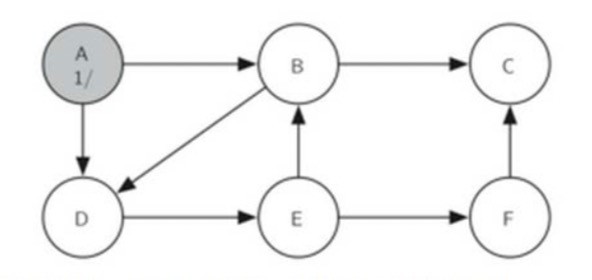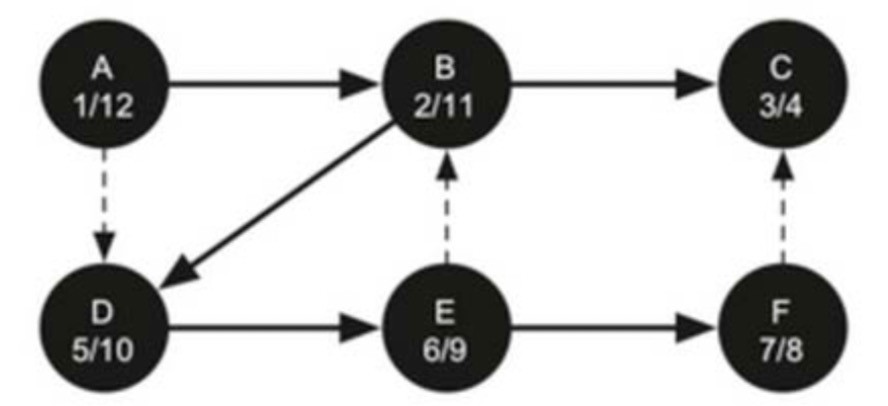圖
圖(Graph)是由頂點和連接頂點的邊構成的離散結構。在計算機科學中,圖是最靈活的數據結構之一,很多問題都可以使用圖模型進行建模求解。圖的結構很簡單,就是由頂點集和邊集構成,因此圖可以表示成G=(V,E)。 它也分爲無向圖、有向圖、加權圖。
在使用圖地過程中經常會用到隊列、優先隊列、棧等的輔助。所以本例中除了圖相關的定義外,還定義了隊列和優先隊列。
定義隊列類
class Queue():
# 定義隊列類,先進先出
def __init__(self):
self.items = []
def isEmpty(self):
return self.items == []
def enqueue(self, item):
self.items.insert(0, item)
def size(self):
return len(self.items)
def dequeue(self):
return self.items.pop()定義圖中的頂點
class Vertex:
# 包含了頂點信息,以及頂點連接邊信息
def __init__(self, key):
self.id = key
self.connectedTo = {}
self.distance = 0 # 距離
self.previous = None # 標記前一個頂點
self.color = 'white'
self.disc = 0 # 標記discoveryTime
self.fin = 0 # 標記finishTime
def getId(self):
return self.id
def addNeighbor(self, nbrKey, weight):
self.connectedTo[nbrKey] = weight
def getConnections(self):
return self.connectedTo.keys()
def __str__(self):
return str(self.id) + ' connectedTo: ' + str([x.id for x in self.connectedTo])
def getWeight(self, nbrkey):
return self.connectedTo[nbrkey]
def setColor(self,color):
self.color = color
def getColor(self):
return self.color
def setDistance(self, distance):
self.distance = distance
def getDistance(self):
return self.distance
def setPred(self,preVertex):
self.previous = preVertex
def getPred(self):
return self.previous
def setDiscovery(self,dtime):
self.disc = dtime
def getDiscovery(self):
return self.disc
def setFinish(self,ftime):
self.fin = ftime
def getFinish(self):
return self.fin定義圖
class Graph:
# 包含了各頂點和連接邊的圖
def __init__(self):
self.vertList = {}
self.numVertices = 0
def addVertex(self, key):
self.numVertices += 1
newVertex = Vertex(key)
self.vertList[key] = newVertex
return newVertex
def getVertex(self, key):
if key in self.vertList:
return self.vertList[key]
else:
return None
def __contains__(self, key):
return key in self.vertList
def addEdge(self, fromKey, toKey, cost=0):
if fromKey not in self.vertList:
nv = self.addVertex(fromKey)
if toKey not in self.vertList:
nv = self.addVertex(toKey)
self.vertList[fromKey].addNeighbor(self.vertList[toKey],cost)
def getVertices(self):
return self.vertList.keys()
def __iter__(self):
return iter(self.vertList.values())圖的應用舉例1--詞梯
WordLetter 方法1: 首先將所有單詞作爲頂點加入圖中,再高潮建立頂點之間的邊; 它的時間複雜度爲O(n^2),n爲單詞個數。
方法2: 創建多個桶,每個桶可以存儲多個單詞,桶使用通配符""作爲標記,""佔空一個字母,所以匹配標記的單詞都放到同一個桶中;然後再對同一個桶中的單詞之間建立邊。
def buildWordGraph(wordFile):
d = {}
g = Graph()
wfile = open(wordFile,'r')
for line in wfile:
word = line[:-1]
for i in range(len(word)):
#每個單詞產生四種bucket,判斷字典中是否存在該桶,如果存在則該桶直接追加單詞,如果不存在則創建該桶,並存放單詞
bucket = word[:i] + '_' + word[i+1:]
if bucket in d:
d[bucket].append(word)
else:
d[bucket] = [word]
#爲每個桶中的不同單詞建立邊
for bucket in d.keys():
for word1 in d[bucket]:
for word2 in d[bucket]:
if word1 != word2 :
g.addEdge(word1, word2)
return g廣度優先搜索算法Breadth First Search(BFS)
給定圖G 及開始搜索的起始頂點s: BFS搜索所有從s可到達目標頂點的邊;在達到更遠距離k+1的頂點之前,BFS會找到全部距離爲k的頂點;
可以把s想象成爲樹根,構建一棵樹的過程,從頂點向下逐步增加層次,BFS可以保證在增加距離(層次)之前,添加了所有兄弟節點到樹中。從隊首取出一個頂點作爲當前頂點(出隊);遍歷從當前頂點到鄰接頂點,如果是白色,則將其改爲灰色,距離加1,其前驅頂點爲當前頂點,將其加入到隊列中; 遍歷完成後,將當前頂點設置爲黑色,循環回到步驟1的隊首取當前頂點。
def bfs(graph, start):
start.setDistance(0)
start.setPred(None)
vertQueue = Queue()
vertQueue.enqueue(start)
while (vertQueue.size() > 0):
currentVert = vertQueue.dequeue()
for nbr in currentVert.getConnections():
if (nbr.getColor() == "white") :
nbr.setColor('gray')
nbr.setDistance(currentVert.getDistance() + 1)
nbr.setPred(currentVert)
vertQueue.enqueue(nbr)
currentVert.setColor('black')
def traverse(targetVertex):
x = targetVertex
while (x.getPred()):
print(x.getId(), end=" <- ")
x = x.getPred()
print(x.getId())
sourceFile='/Users/yuanjicai/PycharmProjects/stucture/fourletterwords.txt'
wordgraph = buildWordGraph(sourceFile)
bfs(wordgraph, wordgraph.getVertex('FOOL'))
traverse(wordgraph.getVertex('SAGE'))算法分析 : BFS主體使用兩個循環嵌套, while對每個頂點訪問一次,所以複雜度爲O(\V);而內循環for,由於每條邊只有在它的頂點u出隊時纔會被檢查一次,且每個頂點最多出隊一次,所以每條邊最多被檢查1次;
綜合起來BFS的時間複雜度爲O(\V+\E);創建單詞關係圖也需要時間,最多爲O(\v\^2);回逆時的複雜度爲O(n)。
深度優先算法Depth First Search(DFS)
深度優先算法Depth First Search(DFS),它沿着樹的的單支儘量深入向下搜索,如果到無法繼續的程度還未找到問題的解,就回溯到上一層再搜索下一分支.
算法1: 專門解決騎士周遊問題,每個頂點僅訪問一次;
算法2: 允許頂點被重複訪問,可作爲其它圖算法的基礎,更加通用.
解決思路: 如果沿着單支深入搜索到無法繼續(所有合法移動都被走過)時,路徑的長度還沒達到預定值(8*8-1),那麼就清除顏色標記,返回到上一層,然後換一個分支繼續深入搜索. 操作過程需要引入棧來記錄路徑,以便進行回溯操作。
DFS的應用舉例--騎士周遊問題
解決步驟:
- 首先將合法走棋次序表示爲一個圖;
- 其次採用圖搜索算法搜尋一個長度爲(行*列-1)的路徑,路徑上包含每個頂點恰好一次;
- 將棋盤格做爲頂點;按照"馬走日"規則的走棋步驟作爲連接邊;建立每一個棋盤格的所有合法走棋步驟能夠到達的棋盤格關係圖;
def genLegalMoves(x, y, bdSize):
newMoves = []
# 以當前位置x,y座標爲參考,"馬"可以跳的合法相對座標位置
moveOffsets = [(-1,-2),(-1,2),(-2,-1),(-2,1),(1,-2),(1,2),(2,-1),(2,1)]
for i in moveOffsets:
newX = x + i[0]
newY = y + i[1]
if legalCoord(newX, bdSize) and legalCoord(newY, bdSize):
newMoves.append((newX, newY))
return newMoves
def legalCoord(x, bdSize):
if x >= 0 and x < bdSize:
return True
else:
return False
def buildKnightGraph(bdSize):
ktGraph = Graph()
for row in range(bdSize):
for col in range(bdSize):
nodeId = posToNodeId(row, col, bdSize)
newPostions = genLegalMoves(row, col, bdSize)
for e in newPostions:
nextNodeId = posToNodeId(e[0], e[1], bdSize)
# 當前棋格和下一跳產生關係
ktGraph.addEdge(nodeId, nextNodeId)
return ktGraph
def posToNodeId(row, col, bdsize):
#根據行、列座標生成棋盤格的id
return row*bdsize+col
def orderByAvail(currentVertex):
# 將當前節點的neighbor排序,按neighbor是否擁有下一個neighbor的規則排序(一種啓發式算法)
resList = []
for v in currentVertex.getConnections():
if v.getColor() == 'white':
c = 0
for w in v.getConnections():
if w.getColor() == 'white':
c += 1
resList.append((c,v))
resList.sort(key=lambda x: x[0])
return [y[1] for y in resList]
def knightTour(n, path, currentVertex, limit):
# n表示層次; path使用列表的append和pop方法實現入棧和出棧;
currentVertex.setColor('gray')
path.append(currentVertex) #遞歸調用 每次都會把當前頂點設置爲'灰色',然後先入棧,如果不滿足條件再出棧
if n < limit:
# nbrList = list(currentVertex.getConnections())
nbrList = orderByAvail(currentVertex) #返回已經排序的neighbor列表,優先從棋盤邊角搜索
i = 0
done = False
while i < len(nbrList) and not done:
if nbrList[i].getColor() == 'white':
done = knightTour(n + 1, path, nbrList[i], limit)
i += 1
if not done:
path.pop() # 如果不滿足條件,則把當前頂點從棧中彈出
currentVertex.setColor('white')
else:
done = True
return done
n = 5
kgGraph = buildKnightGraph(n) #生成5行5列的圖(棋盤)
resultPath = [] #可行路徑
start = 4 #開始搜索的節點
knightTour(0, resultPath, kgGraph.getVertex(start), n * n - 1)
print("可行路徑爲", end=": ")
for i in range(len(resultPath)): #輸出路徑
if i != len(resultPath) - 1:
print(resultPath[i].getId(), end=' ->')
else:
print(resultPath[i].getId())另一種比較通用的DFS算法
它需要擴展原Graph類,如下所示:
class DFSGraph(Graph):
def __init__(self):
super().__init__()
self.time = 0
def dfs(self):
for aVertex in self:
aVertex.setColor('white')
aVertex.setPred("None")
for aVertex in self:
if aVertex.getColor() == 'white':
self.dfsvisit(aVertex)
def dfsvisit(self,startVertex):
startVertex.setColor('gray')
self.time += 1
startVertex.setDiscovery(self.time)
for nextVertex in startVertex.getConnections():
if nextVertex.getColor() == 'white':
nextVertex.setPred(startVertex)
self.dfsvisit(nextVertex)
startVertex.setColor('black')
self.time += 1
startVertex.setFinish(self.time)
按上圖構建Graph如下所示
def buildTestGraph():
g = DFSGraph()
list1 = ['A', 'B', 'C', 'D', 'E', 'F']
for i in list1:
g.addVertex(i)
g.addEdge('A', 'B')
g.addEdge('A', 'D')
g.addEdge('B', 'C')
g.addEdge('B', 'D')
g.addEdge('D', 'E')
g.addEdge('E', 'F')
g.addEdge('E', 'B')
g.addEdge('F', 'C')
return g
testGraph = buildTestGraph()
testGraph.dfs()
d1 = {}
l1 = []
for key in testGraph.getVertices():
currentVertex = testGraph.getVertex(key)
d1[currentVertex.getId()] = (currentVertex.getDiscovery(), currentVertex.getFinish())
l1.append((currentVertex.getId(), currentVertex.getDiscovery(), currentVertex.getFinish()))
l1.sort(key=lambda tup: tup[2], reverse=True)
print("深度優先算法(DFS)遍歷圖後的結果(列表輸出方式)如下: %s" % l1)
d2 = sorted(d1.items(), key=lambda tup: tup[1])
print("深度優先算法(DFS)遍歷圖後的結果(字典輸出方式)如下: %s" % d2)DFS後Graph的效果如下:
以上代碼輸出結果如下:
深度優先算法(DFS)遍歷圖後的結果(列表輸出方式)如下: [('A', 1, 12), ('B', 2, 11), ('D', 5, 10), ('E', 6, 9), ('F', 7, 8), ('C', 3, 4)]
深度優先算法(DFS)遍歷圖後的結果(字典輸出方式)如下: [('A', (1, 12)), ('B', (2, 11)), ('C', (3, 4)), ('D', (5, 10)), ('E', (6, 9)), ('F', (7, 8))]Dijkstr算法
Dijkstra首先把起點到所有點的距離存下來找個最短的,然後鬆弛一次再找出最短的,所謂的鬆弛操作就是,遍歷一遍看通過剛剛找到的距離最短的點作爲中轉站會不會更近,如果更近了就更新距離,這樣把所有的點找遍之後就存下了起點到其他所有點的最短距離。Dijkstra算法只能用於邊權爲正的圖,時間複雜度爲O(n^2)。
class PriorityQueue:
def __init__(self):
self.heapArray = [(0,0)]
self.currentSize = 0
def buildHeap(self,alist):
self.currentSize = len(alist)
self.heapArray = [(0,0)]
for i in alist:
self.heapArray.append(i)
i = len(alist) // 2
while (i > 0):
self.percDown(i)
i = i - 1
def percDown(self,i):
while (i * 2) <= self.currentSize:
mc = self.minChild(i)
if self.heapArray[i][0] > self.heapArray[mc][0]:
tmp = self.heapArray[i]
self.heapArray[i] = self.heapArray[mc]
self.heapArray[mc] = tmp
i = mc
def minChild(self,i):
if i*2 > self.currentSize:
return -1
else:
if i*2 + 1 > self.currentSize:
return i*2
else:
if self.heapArray[i*2][0] < self.heapArray[i*2+1][0]:
return i*2
else:
return i*2+1
def percUp(self,i):
while i // 2 > 0:
if self.heapArray[i][0] < self.heapArray[i//2][0]:
tmp = self.heapArray[i//2]
self.heapArray[i//2] = self.heapArray[i]
self.heapArray[i] = tmp
i = i//2
def add(self,k):
self.heapArray.append(k)
self.currentSize = self.currentSize + 1
self.percUp(self.currentSize)
def delMin(self):
retval = self.heapArray[1][1]
self.heapArray[1] = self.heapArray[self.currentSize]
self.currentSize = self.currentSize - 1
self.heapArray.pop()
self.percDown(1)
return retval
def isEmpty(self):
if self.currentSize == 0:
return True
else:
return False
def decreaseKey(self,val,amt):
# this is a little wierd, but we need to find the heap thing to decrease by
# looking at its value
done = False
i = 1
myKey = 0
while not done and i <= self.currentSize:
if self.heapArray[i][1] == val:
done = True
myKey = i
else:
i = i + 1
if myKey > 0:
self.heapArray[myKey] = (amt,self.heapArray[myKey][1])
self.percUp(myKey)
def __contains__(self,vtx):
for pair in self.heapArray:
if pair[1] == vtx:
return True
return False
import sys
def dijkstra(routeGraph,start):
for v in routeGraph:
v.setDistance(sys.maxsize)
pq = PriorityQueue()
start.setDistance(0)
pq.buildHeap([[v.getDistance(), v] for v in routeGraph])
while not pq.isEmpty():
currentVertex = pq.delMin()
for nextVert in currentVertex.getConnections():
newDist = currentVertex.getDistance() + currentVertex.getWeight(nextVert)
if newDist < nextVert.getDistance():
nextVert.setDistance(newDist)
nextVert.setPred(currentVertex)
pq.decreaseKey(nextVert, newDist)
按上圖構建Graph如下所示:
def buildRouteGrap():
g = Graph()
g.addEdge("u", "v", 2)
g.addEdge("u", "x", 1)
g.addEdge("u", "w", 5)
g.addEdge("v", "w", 3)
g.addEdge("v", "x", 2)
g.addEdge("x", "w", 3)
g.addEdge("x", "y", 1)
g.addEdge("y", "w", 1)
g.addEdge("y", "z", 1)
g.addEdge("w", "z", 5)
return g
routeGraph = buildRouteGrap()
dijkstra(routeGraph, routeGraph.getVertex("u"))
def traversRoute(targetVertex):
if targetVertex.previous:
print(targetVertex.previous.getId(), end="<-")
traverse(targetVertex.previous)
print("Dijkstra後 源路由器 u 到目標路由器 w 的最佳路徑是: ", end=" ")
traverse(routeGraph.getVertex('w'))經過dijkstra之後的Graph效果如下:
上述代碼執行結果如下:
Dijkstra後 源路由器 u 到目標路由器 w 的最佳路徑是: w <- y <- x <- u最小生成樹(minimum weight spanning tree)
生成樹:擁有圖中所有頂點和最少數量的邊,以保持連通的子圖。
圖G(V,E)的最小生成樹T,定義爲包含所有頂點V,以及邊E的無圈子集,並且邊權重之和最小。
解決最小生成樹問題的Prim算法屬於"貪心算法",即每步都沿着最小權重的邊向前搜索。
def prim(routeGraph, start):
pq = PriorityQueue()
for v in routeGraph:
v.setDistance(sys.maxsize)
v.setPred(None)
start.setDistance(0)
pq.buildHeap([(v.getDistance(), v) for v in routeGraph])
while not pq.isEmpty():
currentVertex = pq.delMin()
for nextVertex in currentVertex.getConnections():
newCost = currentVertex.getWeight(nextVertex)
if nextVertex in pq and newCost < nextVertex.getDistance():
nextVertex.setPred(currentVertex)
nextVertex.setDistance(newCost + currentVertex.getDistance())
pq.decreaseKey(nextVertex, newCost)
按上圖構建Graph, 如下所示:
def buildRouteGraph2():
g = Graph()
g.addEdge("A", "B", 2)
g.addEdge("A", "C", 3)
g.addEdge("B", "C", 1)
g.addEdge("B", "D", 1)
g.addEdge("B", "E", 4)
g.addEdge("D", "E", 1)
g.addEdge("E", "F", 1)
g.addEdge("C", "F", 5)
g.addEdge("F", "G", 1)
return g
routeGraph2 = buildRouteGraph2()
prim(routeGraph2, routeGraph2.getVertex("A"))
print("prim後 源路由器 A 到目標路由器 G 的最佳路徑是: ", end=" ")
traverse(routeGraph2.getVertex('G'))運行結果如下:
prim後 源路由器 A 到目標路由器 G 的最佳路徑是: G <- F <- E <- D <- B <- A關於本例中優先隊列類的測試如下:
testList = [(4, "a"), (3, "d"), (5, "c"), (2, "e"), (1, "f")]
pq = PriorityQueue()
pq.buildHeap(testList)
# for elem in testList:
# pq.add(elem)
print("本例中優先隊列的刪除順序爲:", end=" ")
while not pq.isEmpty():
print(pq.delMin(), end=" -> ")輸出結果如下:
本例中優先隊列的刪除順序爲: f -> e -> d -> a -> c ->




